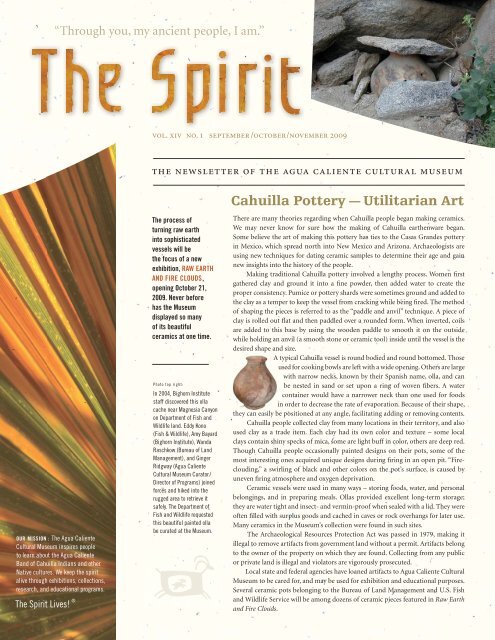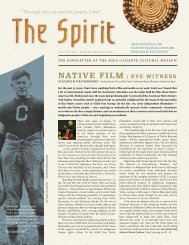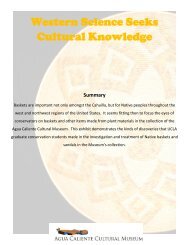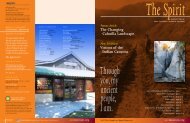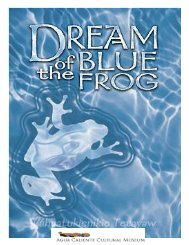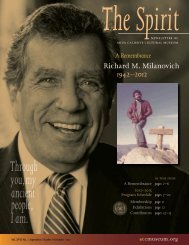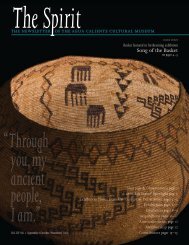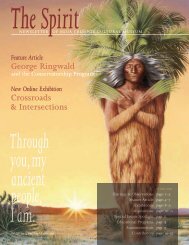accm newsletter2_20pg_FINAL.indd - Accarchives.org
accm newsletter2_20pg_FINAL.indd - Accarchives.org
accm newsletter2_20pg_FINAL.indd - Accarchives.org
- No tags were found...
Create successful ePaper yourself
Turn your PDF publications into a flip-book with our unique Google optimized e-Paper software.
Mildred Brownechairwoman, board of directorsWhen I received my invitation to Dinner in the Canyons, I was reminded of so many other years of thisfabulous event. It is hard to believe that this will be our 19th! It all began when the Board met to develop anew fundraiser. The Museum’s original outdoor Heritage Festival was quite popular, but we wanted to comeup with another signature event to help spread the word about our Museum, build membership, and raisefunds to help underwrite the cost of exhibitions and educational programs.The first Dinner in the Canyons was a simple affair. We sat at picnic tables enjoying traditional western-stylebarbecue. A ticket cost only $35 and close to 150 people came. A few years later, Chef Paul Woods of the SpaResort Casino created a more “up-scale” version of the event, introducing food stations. About 10 years ago, wetook it up another notch, presenting amazing sit-down dinners that often include buffalo, venison, and nativevegetables. Not an easy feat to cook for 500 people in the Canyons with no ready access to water and electricity!Vendors who participated in the early years provided opportunities to purchase unique art objects by suchrenowned artists as David Salk and Tony Soares. The Trading Post at the Canyons even took part. We havesince moved from the booth-style selling of objects to the live auction of four or five items each year. Again,this year, we will feature some absolutely stunning and unique items.Each year, Dinner in the Canyons evolves. We’ve had cocktails before entering the Canyons; for many yearsboth cocktails and dinner were in the area currently used for the reception; we now use both areas in AndreasCanyon – watching the cityscape at sunset and enjoying dinner under a clear, star-lit sky. We’ve dealt with windand the threat of rain – I have even heard that a coyote once checked out what was going on after the eveningwas over…our event planner was a bit surprised to encounter him.Entertainment over the years has included local performers and those of other indigenous cultures. Lastyear we welcomed Andrea Menard, a First Nations Canadian. This year we will honor Native Hawaiians.Despite the outward changes, we haven’t changed the reason for having Dinner in the Canyons. This is ourmajor fundraising event to support the Museum’s programs. Also, it has become the Coachella Valley eventthat signals the “season” has begun. What better way to open a year of celebratory events than by having thedescendants of the people who first lived here welcome old friends and new friends to our home? We still lookto Dinner in the Canyons as an important way to spread the word about our Museum, build membership,and raise funds.I hope to see you there. As our Native Hawaiian friends say, “Mahalo!”Board Member PerspectiveJoseph A. Roman, Esq.board memberWhen I was a young boy growing up in Palm Springs in the 1960s, in order to stay cool during the summer,I used to hang out at the Welwood Murray Library in downtown Palm Springs where my grandmotherChristine was a librarian. In those days, the tiny Palm Springs Desert Museum was right next door on Tahquitzand my grandmother used to take me there to show me the ollas, baskets, and other Native American objectson display, and to tell me stories about the terrible things “the white man had done to the Indian.” Born in1919 in Cherokee County, Oklahoma, she grew up amidst the intolerance and discrimination of whites towardminorities. Perhaps because she was such a kind, intelligent, and sensitive soul, she was always the champion ofthe underdog, particularly Native Americans. She often told the story – in her distinctive southern accent – ofhow “the white men of Palm Springs had run the poor Indians and blacks right out of town,” referring to theeviction of Native Americans and other minorities from Section 14 in the 1960s. And she always used to tell me,“Hon, you should be so proud that you’re 1/32 Cherokee Indian.” It is because of her that – some 40 years later –I am particularly honored to serve on the Board of the Agua Caliente Cultural Museum, and proud that I havethe opportunity to carry on – in some small way – her wonderful legacy of tolerance and humanity.3
EducationSummer months at the Museum are all aboutkids, whether they are visiting with family orparticipating in one of the summer classes.They’re creepy, crawly, and,yet, still quite beautiful!At the Living Traditions classDesert Reptiles and Insects,children enjoyed a hands-onlesson about our desert’s livehidden treasures.Summer fun and learning go hand-inhandat Kids Explore! A variety of topicswas covered in the five-session class heldon Wednesdays in July.Left: Kids join O’Jay Vanegas, Director ofEducation, on a tour of the Museum.Right: Now for the fun part! Paper, crayons,markers, scissors, and glue are all youneed to create your own outdoor sceneof a traditional Cahuilla village.Kids Explore! offers a range ofcreative learning opportunities.Basket making is always a bighit with kids of all ages.4
EducationBoarding SchoolRunaways5Flora and Matilda Patenciofl ank their mother, Nicolasa.Photo gift of the Estateof Flora PatencioRenona Penningtoninspired the articleBoarding School Runawayswith information sheprovided in an OralHistory Projectinterview conductedby Agua CalienteCultural Museum.Renona Penningtonis an enrolled memberof the Agua Caliente Bandof Cahuilla Indians andserves on the Museum’sBoard of Directors.Historically, the United States government has pursued the destructionof American Indian culture through the education of Indian children.During the last few decades of the 19th century, the federal governmentturned to a boarding school education system as a means to end the“Indian problem.” In the minds of many progressive reformers, AmericanIndians had not “advanced” far enough in becoming “Americanized” andthe solution appeared to be forced re-education and assimilation. Reformershoped that removing Indian children from their homes and communitieswould insulate them from the “corrupting” influences of their families,cultures, and languages. Boarding school administrators changed thestudents’ appearance, diet, and daily routine drastically. School officialsprohibited the use of Native languages and punished students harshly forany infraction. Not all students accepted the changes thrust upon them.Many students resisted school authorities and forced acculturation byfeigning illness, cutting classes, pretending ignorance, perpetratingpranks, committing sabotage, starting fires, and even running away.continued †
(continued)Renona Pennington remembers one such story of resistance told to her by heraunt, Flora Patencio (1908-1992). Around the time that Flora and her sisterMatilda (Renona’s mother) were in the 2nd or 3rd grade, they began attendingSt. Boniface Indian Industrial School in Banning. Renona describes life forFlora and Matilda before being sent off to the boarding school (circa 1915):“They had a real nice family. They had their mom and their dad. There was justtwo of them, my aunt and my mother. Their mother [Nicolasa] was … a typicalhousewife, you know. Everything was done in order, and three meals a day, andthey just had a perfect little family. I say all that, because they were not used tobeing away from home!” Like most Indian children sent to boarding schools,Flora and Matilda experienced homesickness. The Cahuilla girls’ transitionwent beyond missing their parents and home. At St. Boniface, Matilda beganto get sick and Renona attributes her mother’s illness to the change in diet atthe school.Much of the food at boarding schools was new to Indian children, and inadequatebudgets meant the meals lacked basic nutrition. Moreover, St. Boniface reliedon donations of food to supplement meals. Frequently, large donations of foodresulted in serving the same food until the supply was exhausted. Instead ofeating a variety of fresh vegetables from the family garden, Flora told Renonathat at St. Boniface “we had [lima] beans for breakfast, [lima] beans for lunch,[and lima] beans for dinner.” Besides monotony, the change in diet oftencaused problems among Indian children including childhood diabetes andcompromised immune systems. Flora told Renona that “your mother wasgetting sick,” and Flora planned how they would run away and go home.Flora picked the morning when theywere going to escape and she told Matilda to go to sleepin her clothes. Flora left a window in the hallway open a little so they could gothrough it without making any noise. In the darkness of the early morning, Floraquietly woke up Matilda. They carried their shoes and tip-toed to the window.Slipping out without a sound, Flora and Matilda began the approximate 30mile trek from St. Boniface to Palm Springs. They set off on their journeywithout food or water. Although Renona is not sure of the time of the year, shesuspects it would have to have been late fall or early spring. The time of yearis important because of the extremes of the desert temperature. The monthsof September, May, and June are often dominated by temperatures over 100degrees and as high as 120 degrees, or higher. The winter months, November toMarch, although typically sunny during the day can be cold with temperaturesnear or below freezing at night. Flora did not emphasize one extreme or theother to Renona. It was likely October or April when the two boarding schoolrunaways made their way across the desert because the more moderate seasonalclimate would make the journey less hazardous. Nevertheless, traveling alonein the desert certainly posed other threats: coyotes, rattlesnakes, and simply thedanger of two children getting lost without food or water.8th grade graduating class,St. Boniface, June 9, 1929Photo donation of Corinne SivaSeveral grade levels arerepresented in this phototaken at St. Boniface.Photo donation ofCorinne SivaWith amazement in her voice, Renona remembers “after she told me the story,I said, ‘Auntie, how did you know the way?’” Flora told Renona matter-offactly,“We just followed the base of the mountain.” Flora and Matilda walkedeastward through the pass until they came to a road that they recognized ashaving traveled by wagon with their parents. Along the road they came to alittle store made of rock near Cabazon. Renona says with a smile in her voice6
“It’s still there [but] it’s all painted white now. It’s like a general store and gas[station]. Well, they got to that place, ’cause they were way off in the desert.”Flora told Renona, “and so, I fixed your mother under a tree, not a tree, a bush.”Renona speculates that Flora must have had some small change. “A few nickelsor dimes or something. She went over there. I guess nobody seen, you know [toask], ‘What’s a schoolgirl doing by herself?’ And she bought one bottle of pop.They called it pop.” Flora brought the soda to Matilda and they drank it underthe bush before getting on their way.It was nearly dark by the time Flora andMatilda reached Palm Springs. After a longhot day the Patencio family often sat outside to smoke and talk. Renonaremembers, as a child, sitting out and talking with Flora. Renona continues,“Well, it was dusk. They were sitting out there, and all of a sudden one of themen seen something way over there, kind of moving, and they kept lookinglike that, looking like that, and they, so after a while they said, ‘You know what?Those are people!’ One of the men got his horse and rode to where they saw thepeople, finding Flora and Matilda. The girls got on the horse and rode the restof the way home.” Renona says about their father’s reaction, “My grandfather[Albert Patencio] was so mad. He was mad at the school!” Flora and Matildahad walked all day from sunrise to sunset. They did not carry water with them.There were no trees for shade and no water along the way. As Renona says, “Itwas all desert.”Not long after Flora and Matilda finally arrived home, the priest from St. Bonifacearrived on horseback; it had taken him all day to reach the Patencio home.Renona tells how her grandfather reacted to the priest who was responsible forhis daughters’ safety. “My grandfather was so mad at him. [He] just really laidthe law. I mean he was really mad, you know, that these little girls got awaylike that and took them all day to, you know, to get home. And so then I askedFlora, ‘Well, then what happened?’ and she said, ‘We never had to goback.’” Flora and Matilda never returnedto St. Boniface. Renona says, “They werevery happy, but I tell that story, and I justwas so awed about it.”The Bureau of Catholic Indian Missionsfounded St. Boniface Indian IndustrialSchool in 1890. Over one hundred students,from 1st to 8th grade, attended the schooleach year. St. Boniface provided instructionin reading, writing, religious study, and basicarithmetic from the Sisters of St. Joseph.Priests taught students the Catechism.Separated from their families, the students atSt. Boniface adjusted to the foreign boardingschool environment. Memories of boardingschool experiences vary significantly; not allIndian children disliked the schools, althoughmost missed their homes and parents. Butsome of the students and their families, like thePatencios, resisted the boarding school systemto the extent of running away and not sendingtheir children back.
ExhibitionsCurrent Changing ExhibitionsCreating a Legacy:Gifts to the CollectionsThrough October 18, 2009This exhibition is dedicated to the generous people who have donatedover 2,000 items to the collections of Agua Caliente Cultural Museum.The gifts include baskets, paintings, sculpture, kachinas, pottery,archaeological artifacts, Skookum Indian dolls, an Anasazi potteryladle, and archival photos and documents. More than100 items are displayed in this special exhibition.Some of the notedartists represented inthe exhibition include:Allan HouserHarrrison BegayR. C. GormanStar Liana YorkJohn HarteTony SoaresNellie Mike MorongoReginald PollackJuanita NejoKathy (Shirley) KitchenAgua Caliente Tribal members have been especiallyfar-sighted in contributing precious familymemorabilia and photographs so that theknowledge and memories of their ancestorswill be preserved for their descendents.The Museum is grateful to all of the donorsfor their generosity. The wealth of historyand culture inherent in these objects helps usunderstand and tell the stories of indigenouspeoples – past and present.This exhibition is sponsored byRobert and Renona Pennington.Sticks & Stones... and Other ThingsThrough October 18, 2009The ingenuity of the Cahuilla people is apparent when looking atobjects made from sticks, stones, fibers, bones, and a variety of othernatural materials. This exhibition showcases the Museum’s collectionof rarely-seen hunting and food-processing tools, as well as techniquesfor making them.Left: This Cahuillamortar and pestle wasfound in Palm Canyonwith two pieces of burnedcorn cob, printed cottoncloth fragments, animalbone pieces, and feathersinside.Above: This largegathering basketwith diamond andwhirlwind designswas woven by CasildaWelmas (Cupeño) inthe 1920s after theforced removal ofthe Cupeño peopleto the Pala reservation.8
Raw Earthand Fire CloudsOctober 21, 2009 through October 17, 2010New ExhibitionsPottery began with the Cahuilla people long after basketry had reacheda high level of artistry. At least 500 years ago, pottery techniques wereadopted to supplement baskets as utensils for storage and cooking.Local clays were processed and coiled in shapes to hold water, seeds,and pigments. This exhibition interprets the full spectrum of potteryfrom clay sources, manufacture, pigments and painting, to firing thefinished product.This exhibition is sponsored by Debbie, Anthony & Andrew Purnel,and Ambrosia M. Howell. In Memory of Priscilla Patencio GonzalesLeft: Most painted ollas have red designmotifs in vertical bands. This jar, found inthe Coachella Valley, features brown designscircling the jar in horizontal bands.Kennewick Man on TrialOctober 21, 2009 through March 21, 2010† A Spirit Keepers lecture byDr. James Nason (Comanche),who created the exhibition,will provide a forum for attendeesto ask questions and contributeopinions. The lecture will takeplace in the Indian Wells Theaterat California State University,San Bernardino, Palm Desert Campus,on November 17 at 6:30 pm.Don’t miss these opportunities tolearn about new perspectives onearly humans in North America.Exhibition Features Controversy over Ancient SkeletonKennewick Man on Trial addresses the ongoing controversy surrounding thediscovery of a human skeleton uncovered in Washington State. Native tribesof the area, archaeologists, and anthropologists have vigorously disagreed onwho Kennewick Man may be and where his remains belong.The exhibition opens October 21at the Museum with a receptionat 6:00 pm.Illustration by Joyce Bergen, 1999CMA projectile point – similar to the one inthis photo – was lodged in Kennewick Man’sright hip and analyzed by researchers tohelp determine Kennewick Man’s age.Kennewick Man on Trial was developed by theBurke Museum of Natural History and Cultureat the University of Washington in Seattle.Photo courtesy of the Burke Museum9
Permanent ExhibitionsA Woman of Influence: Flora PatencioThis exhibition is a study of Flora Patencio, a strong leader amongthe Agua Caliente people. Flora participated in some of the mostimportant political and cultural decisions of her time.Cahuilla Culture and HistoryPhotographs, maps, and text tell the story of the early times ofthe Cahuilla people. A five-minute film entitled Indian Familyof the California Desert re-enacts the early Cahuilla traditional life.Off-Site Changing ExhibitionsAgua Caliente Cultural Museum shares its resources throughcollaborations with California State University, San Bernardino,Palm Desert; the City of Palm Springs; and other institutions.Off-site exhibitions offer a unique glimpse of local history foruniversity students and Coachella Valley residents and visitors.Dream of the Blue Frog (Wahaatukicnikic Tetayaw)Learn more about the history and lore of the Agua Caliente Hot Springfrom ancient times to the present.WHEN: Through September 18, 2009WHERE: Palm Springs City Hall3200 E. Tahquitz Canyon WayWHEN: Opens September 23, 2009WHERE: Spa Resort Casino Hotel – location of the hot spring100 N. Indian Canyon Drive, Palm SpringsTahquitz CountryExplore symbols and artwork of the Cahuilla people through designs usedin pottery, basketry, and rock art. Take a photographic journey through theheart of Cahuilla territory — the home of shaman Tahquitz.WHEN: OngoingWHERE: California State University, San Bernardino, Palm Desert Campus37500 Cook Street, Palm DesertCrossroads & IntersectionsDiscover the history of Palm Springs street names and the Cahuilla leadersafter whom they are named.WHEN:WHERE:Ongoing115-121 S. Palm Canyon Drive at Tahquitz Canyon WayPalm Springs†††††††Join theMuseum!2009-2010Membership DriveYour membership supportwill help preserve and shareNative gifts of culture, andenrich the quality of life foreveryone who lives in andvisits the Coachella Valley.Become a member and beginenjoying the benefits of yourtax-deductible contribution:Invitations to exhibitionopening receptionsInvitations to lectures and classes,Native cultural festivals, Dinnerin the Canyons, and otherspecial Museum eventsNew! Free registration for LivingTraditions classes on native skillsand craftsOne-year (4 issues) subscriptionto The Spirit – the Museum’sfull-color newsletterOne-year (12 issues) subscriptionto Smithsonian magazineand member recognition inThe Spirit newsletter(donors circle members only)15% discounton Museum Store purchases15% discounton Museum Library and Archivesmaterials reproduction servicesJoining Agua Caliente CulturalMuseum is easy. Simply completeand return the membershipenvelope attached to the enclosedbrochure today!2009-2010 Exhibition Print Media Sponsor10
september 23Exhibition OpensDream of the Blue Frog (Wahaatukicnikic Tetayaw)DATE: Wednesday, September 23TIME: 10:00 amLOCATION: Spa Resort Casino Hotel100 N. Indian Canyon Drive, Palm SpringsCalendarseptember 25Native American Day ProclamationThe State of California has declared the fourth Friday of SeptemberNative American Day. To celebrate, the City of Palm Springs will issuea proclamation to the Museum.DATE: Friday, September 25TIME: 10:30 amLOCATION: Agua Caliente Cultural Museum219 S. Palm Canyon Drive, Palm SpringsAgua Caliente Cultural Museum is thefi rst Native American museum to be partof the Smithsonian Institution Affi liationsProgram. This status provides opportunitiesto share resources in programming,collections, scholarship, and technicalexpertise – and entitles the Museumto bring world-acclaimed Smithsonianexhibitions to the Coachella Valley.september 26Smithsonian Magazine Museum Day 2009Smithsonian Magazine Museum Day features a special opportunityfor members (new and current) to receive a 12-month subscription toSmithsonian magazine and other Museum benefits.DATE: Saturday, September 26TIME: 10:00 am – 5:00 pmLOCATION: Agua Caliente Cultural Museum219 S. Palm Canyon Drive, Palm Springsoctober 21Exhibition Opening ReceptionRaw Earth and Fire CloudsThis exhibition interprets the full spectrum of pottery from clay sources,manufacture, pigments and painting, to firing the finished product.DATE: Wednesday, October 21, 2009TIME: 6:00 pm – 8:00 pmLOCATION: Agua Caliente Cultural Museum219 S. Palm Canyon Drive, Palm Springs
october 21Exhibition Opening ReceptionKennewick Man on TrialKennewick Man on Trial explores important legal, ethical, andscientific issues raised by the 1996 accidental discovery of a nearlycomplete male skeleton in Kennewick, Washington.DATE: Wednesday, October 21, 2009TIME: 6:00 pm – 8:00 pmLOCATION: Agua Caliente Cultural Museum219 S. Palm Canyon Drive, Palm Springsoctober 24Whole Rod Juncus Baskets – Living Traditions ClassWhole rod juncus basket making uses a simple technique to createutilitarian baskets. Renowned basket weaver Abe Sanchez (Purepecha)will teach students the basic principals of weaving and how to constructtheir own whole rod basket. Class fee includes materials.DATE: October 24, 2009TIME: 10:30 am – 4:00 pmLOCATION: Agua Caliente Cultural Museum219 S. Palm Canyon Drive, Palm SpringsFEE: $3512
november 13–15Baskets and Books with Pauline MurilloCalendarLeft: Basket from the collectionof Pauline MurilloPhoto courtesy of CaliforniaState University, San BernardinoPauline Murillo (San Manuel), author and basket collector, will be atthe Museum for three days only. She will show and talk about her basketcollection with visitors. Baskets made by her grandmother are specialpieces she will share. She is the author of Living in Two Worlds andWe Are Still Here Alive and in Spirit which relate her experiencesgrowing up on the reservation with insight and humor.DATE: November 13, 14, and 15, 2009TIME: Regular Museum hoursLOCATION: Agua Caliente Cultural Museum219 S. Palm Canyon Drive, Palm Springsnovember 17Kennewick Man on Trial – Spirit Keepers LecturePRESENTER: James D. Nason, Ph.D. (Comanche)Dr. James D. Nason is Professor Emeritus, Anthropology; DirectorEmeritus, Museology Graduate Program; and Curator Emeritus ofPacific and American Ethnology, Thomas Burke Memorial WashingtonState Museum, at the University of Washington. He is principalcurator for Kennewick Man on Trial and author of a legal andhistorical review of the issues in the 2008 book, Kennewick Man:Perspectives on the Ancient One.The lecture follows the October 21 opening of the exhibition KennewickMan on Trial.DATE: Tuesday, November 17, 2009TIME: 6:30 pm – 8:30 pmLOCATION: California State University, San Bernardino, Palm Desert Campus,37500 Cook Street, Palm Desert (Indian Wells Theater)FEE: Free Admissionnovember 21Journeys to the Past – Living Traditions ClassINSTRUCTOR: Jacque Nunez (Acjachemen descendant)Jacque Nunez teaching a recentLiving Traditions classJacque Nunez will whisk you away to the past through the power ofstorytelling and song. Participants recreate Native American stories,learn authentic California Indian songs, play games, and make their ownmusical instrument. Family participation is welcome.DATE: November 21, 2009TIME: 10:30 am – 4:00 pmLOCATION: Agua Caliente Cultural Museum219 S. Palm Canyon Drive, Palm SpringsFEE: $10132009-2010 Education Program Print Media Sponsor
Announcementsnew member of the board of directorsVirginia Siva GillespieAn active role in Tribalgovernment was always inVirginia Siva Gillespie’s plans.The daughter of Edmund PeterSiva and Bernadine Siva, shewas destined to follow in theirfootsteps when it came tostewardship of her culture.Her father’s service on TribalCouncil, including time asChairman, led to her owninvolvement.Her appointment to the Board of Directors of Agua Caliente CulturalMuseum comes following her terms as a Tribal Council member overthe last eight years. During her time on Council, Virginia was the Tribe’sliaison to the Museum as an ex-officio member of the Board. “I amcommitted to spreading the word about the Cahuilla people,” she says.“We need to get the story out there; we need to make people aware thatwe are here today, participating fully in community life.”While on Tribal Council, Virginia helped secure Tribal memberinsurance coverage and was part of the team that initiated buildingthe Spa Casino and the Agua Caliente Casino. “These are two of myproudest accomplishments,” she says. Her top priorities as a memberof the Museum Board are building the planned 110,000 square footfacility and the continuation of open communications with both Tribalmembers and the community.A graduate of Palm Springs High School, Virginia and husbandAndrew reside in Rancho Mirage.Museum to Collaborate withPalm Springs Public LibraryThe celebration of Native American Dayon Friday, September 25 (see Calendarlisting in this newsletter), begins early inPalm Springs. The Palm Springs PublicLibrary will honor the Museum and theAgua Caliente Band of Cahuilla Indiansthroughout the month of September,featuring Since Time Immemorial, adisplay of photos, archival documents,and books depicting the role of the AguaCaliente Band of Cahuilla Indians in thehistory and development of the City.In addition to the photo display, MuseumExecutive Director Michael Hammondwill speak at the Library on Tuesday,September 22, at 6:30 pm. His topic will beAspects of Native America: things you neverknew about food, language, and history.Members of the Museum Board of Directorswill participate in the Library’s storytime activities on Thursdays throughoutSeptember. READ-TO-ME is for toddlersup to age 3, from 10:00-11:00 am, followedby BUSY-FINGERS at 11:00-11:50 am forchildren ages 3–5 years.Chairwoman Millie Browne and otherswill read children’s stories based on NativeAmerican culture and topics. The project,a collaboration of the Library, the Museum,and the Agua Caliente Band of CahuillaIndians, is an example of the cooperativeefforts of Valley partners. For moreinformation, call Youth Services at 323-8199at the Palm Springs Public Library. TheLibrary is located at 300 S. Sunrise Way,on the corner of Baristo Road and SunriseWay in Palm Springs, 760-322-READ (7323)www.palmspringslibrary.<strong>org</strong>.14
Donna Mae Tortes Largo | It is with great sadness that we reportthe passing of Donna Mae Tortes Largo on March 4, 2009, at age 64. Heraccomplishments and influences are too numerous to include in one newsletterarticle. Most remember Donna as a basket maker and teacher; but to thosewho knew her well, she was much more.A member of the Santa Rosa Band of Cahuilla Indians, she was born at the Indianhospital on Soboba Reservation and spent most of her life in the Hemet area. Sheis survived by her husband Anthony and three sons, John, David and Joseph; herbrother Augustine, two grandchildren, and an extended family.Donna was the Indian education program coordinator for the Hemet UnifiedSchool District in the 1970s and 1980s. She worked as a community healthrepresentative and educator with the nonprofit <strong>org</strong>anization Riverside-SanBernardino County Indian Health for 20 years until she retired in 2008.Donna had a wealth of knowledge about plants, and became concerned thatdoctors sometimes prescribed drugs that interacted with traditional plantmedicines. As a result, she co-authored a book in 2006 to familiarize Westernphysicians with the medicinal plants and their chemical constituents used byNative Americans in southern California.While working for the Indian education program, Donna invited a basket makerfrom Soboba Reservation, Elizabeth Mojada, to teach students to make Cahuillabaskets. None of the students continued the craft, but Donna learned the basics ofbasket weaving at that time, and became close friends with Mojada. Donna becamean exceptional basket weaver who inspired many. Her baskets have since beencollected by museums and private collectors, and exhibited on several occasions.She was sought after to speak and give cultural demonstrations for events atmuseums, schools, universities, parks and other institutions and <strong>org</strong>anizations.She curated exhibits at the San Diego Museum of Man. Donna’s enthusiasm andcontribution of family photos and information helped create the Cahuilla Cowboys– Making Our Marks exhibition at Agua Caliente Cultural Museum, which wonthe Charles Redd Award for Exhibition Excellence.In conjunction with Agua Caliente Cultural Museum, she trained students ingathering and weaving Cahuilla basket materials as part of the UCLA/GettyProgram in Ethnographic and Archaeological Conservation – the first suchacademic program of its kind on the west coast.Donna Largo standing in frontof her grandfather’s picture atthe opening of the CahuillaCowboys exhibition at AguaCaliente Cultural Museum, 2007Beginning in 1983, Donna encouraged her friend and student Maree Cheathamto videotape her classes, demonstrations, and other presentations so that whenshe was gone her information would live on. This footage is now archived at theAgua Caliente Cultural Museum. It is currently being edited into an educationaldocumentary by Maree with the assistance of Daniel McCarthy, San BernardinoNational Forest Tribal Relations Program Manager, and Dawn Wellman, AguaCaliente Cultural Museum Assistant Curator.Of all Donna’s accomplishments, she was most proud of founding Nex’wetem,the Southern California Basketweavers Association. She felt basketry was atangible and widely-recognized symbol of culture and should never be lost.Donna co-founded the <strong>org</strong>anization with Lorene Sisquoc, Rosemary Morillo,Daniel McCarthy, and Michael Rodarte. The <strong>org</strong>anization sponsors weavingcircles and classes that are open to the public; its members also maintain basketrymaterials gathering sites.Kind, generous, hardworking and tireless, Donna was devoted throughout her lifeto family, Tribe, and community. She will be missed, but her legacy lives on.
AcquisitionsAgua Caliente Cultural Museum recently acquired the following itemsto add to the growing collections.DonationsGift of the Estate of Patricia & Forrest H. Paulson† Elva Nampeyo pottery jar† Two Mesa Verde area pottery bowls† Large pottery jarGift of Millie Browne† Booklet: All that Glitters is not Gold† Documents: Deposition of Edward Ainsworthand Proposed Zoning for Agua Caliente ReservationPottery by Elva Nampeyo,Hopi, 3rd generation potter.Elva follows the traditionsset by her mother, Fannie,and her grandmother, Nampeyo.Nampeyo revived the ancientpatterns and forms of potteryfound in the ruins of the13th Century Pueblo Sikyatki.Gift of Debbie Purnel† Nambé clock memento, Agua Caliente Casino opening† Two children’s aprons† Bowling league items with tribalmembers’ informationGift of Sean Milanovich† Film reel: Indian Familyof the California DesertPurchases† Photo album with MorongoReservation photographs† Miscellaneous local historic postcards16
ContributorsAgua Caliente Cultural Museum, with a governing board of directors and professional staff, is a 501(c)(3) not-for-profit <strong>org</strong>anizationthat welcomes financial support for its mission from a broad range of individuals and donor <strong>org</strong>anizations. Gifts to the Museumare tax-deductible. Contributions received after July 31, 2009 will be recognized in the next issue of The Spirit. For additionalinformation about how you can support the Museum, please contact Steve Sharp, Director of Development, at 760.778.1079, Ext. 103.Agua CalienteCultural MuseumCapital CampaignContributions to theAgua Caliente CulturalMuseum Capital Campaignare used to help fundconstruction of a new110,000 sq ft Museumfacility in the heart ofPalm Springs.17Agua Caliente Band of Cahuilla IndiansThe Autry FoundationMillie & Dave BrowneIn Memory of Elizabeth Pete Monk& Ray L. Patencio, Sr.Brianna R. DuranIn Memory of Daryl Pennington& Rosella WelmasPriscilla Patencio GonzalesAnnette Segundo GuzmanIn Honor of The Segundo Family& in Memory of John, Mandy,Eugene & Juan SegundoDevin GuzmanIn Honor of The Segundo Family& in Memory of John, Mandy,Eugene & Juan SegundoNastassja Leilani GuzmanIn Honor of The Segundo Family& in Memory of John, Mandy,Eugene & Juan SegundoSydne & Peter HeidrichAmbrosia M. HowellIn Memory of Priscilla Patencio GonzalesLarry & Meg KingIn Honor of grandsonAtom Ray Patencio TravisChristina Marie LewisIn Honor of The Segundo Family& in Memory of John, Mandy,Eugene & Juan SegundoChristopher T. LewisIn Honor of The Segundo Family& in Memory of John, Mandy,Eugene & Juan SegundoDavid James LewisIn Honor of The Segundo Family& in Memory of John, Mandy,Eugene & Juan SegundoLarea Mae LewisIn Honor of The Segundo Family& in Memory of John, Mandy,Eugene & Juan SegundoStacia LewisIn Honor of The Segundo Family& in Memory of John, Mandy,Eugene & Juan SegundoVirginia MilanovichFred H. Morris, Jr.In Memory of Elizabeth Pete Monk& Ray L. Patencio, Sr.Our Savior’s Community ChurchTo fund children’s education facilitiesAlycia A. PatencioIn Memory of Elizabeth Pete MonkAlycia A. Patencio & Reuben TravisIn Memory of Ray L. Patencio, Sr.Candace PatencioIn Memory of Elizabeth Pete Monk& Ray L. Patencio, Sr.John PatencioIn Memory of Elizabeth Pete Monk& Ray L. Patencio, Sr.Ray L. Patencio, Jr.In Memory of Elizabeth Pete Monk& Ray L. Patencio, Sr.Ray L. Patencio, Sr.Mrs. Renona PenningtonIn Memory of Flora PatencioDean W. PieperJoy M. Pierce Teel & Michael TeelIn Memory of Carrie Pierce McCoyFrank PrietoIn Memory of Dora Joyce PrietoMichael PrietoIn Memory of Dora Joyce PrietoAndrew PurnelIn Memory of Priscilla Patencio GonzalesAnthony PurnelIn Memory of Priscilla Patencio GonzalesDebbie PurnelIn Memory of Priscilla Patencio GonzalesBlake Alejo RichardsIn Memory of Dora Joyce PrietoDiana RichardsIn Memory of Dora Joyce PrietoKyle RichardsIn Memory of Dora Joyce PrietoSanborn Civil EngineeringLois Segundo-Workman & Carl WorkmanIn Honor of The Segundo Family& in Memory of John, Mandy,Eugene & Juan SegundoConnie SharpSteve SharpRozene & Ric SuppleTwenty-Nine Palms Band of Mission IndiansUnited States Congress
ContributorsAnnual Giving2009 – 2010Annual tax-deductible contributionsin the form of memberships,sponsorships, grants, tributes, andmatching gifts provide funding thathelps ensure the availability of qualityexhibitions, educational programsfor adults and children, and culturalfestivals throughout the year. Wegratefully acknowledge the supportof our members, sponsors, and othergenerous donors.MembersDonors CircleEagle/Gold($10,000 and above)Lois Segundo-Workman & Carl WorkmanEagle/Silver($5,000 to $9,999)Christopher T. LewisDavid James LewisEagle($1,000 to $2,499)Lowell J. Bean, Ph.D.Dave & Millie BrowneMr. Lee ElsterMr. & Mrs. Boyd F. HaiglerMichael Hammond, Ph.D.& Ms. Rebecca HendricksonJim & Jackie Lee HoustonDr. Frank Lanza & Mr. Richard SwanLinda & David M. Morrow, md, faad, faacsThe Morrow Institute Medical Group Inc.In Honor of the Museum StaffMs. Alycia A. Patencio & Mr. Reuben TravisIn Memory of Ray L. Patencio, Sr.Mr. & Mrs. Ray L. Patencio, Jr.In Honor of Millie BrowneDebbie PurnelIn Memory of Priscilla Patencio GonzalesSteve SharpSoboba Band of Luiseño IndiansMr. & Mrs. Ric SuppleMr. Leon J. Welmas IIPalm($500 to $999)Mr. & Mrs. Stephen M. AndersenAndersen Construction CompanyMr. Gordon D. BrooksMr. & Mrs. Hugh A. LangfordMr. & Mrs. Clint MillerMr. Steve Nichols & Ms. Sally BensonDr. & Mrs. Steven NiethamerCarolyn & Ernest G. NoiaMs. Priscilla A. PeteMs. Connie SharpMs. Karen A. WelmasMesquite($250 to $499)Jean C. CarrusMs. Margaret ColeTiffany & Co.Mr. & Mrs. Robert M. FeyMr. & Mrs. Mark D. GershensonIn Honor of Rebecca HendricksonMrs. Olga H. GianniniMr. Len GoldbergGranite Construction CompanyMr. & Mrs. Earl “Bud” Hoover IIJones & Jones ArchitectsDr. Jüergen KüehnelWilliam Meyer & Mildred BlockMs. Patti A.S. PatencioRobert & Renona PenningtonMs. Eleanor R. PohlSimmie & Keith ShibouMrs. Dorothy WalshPalo Verde($100 to $249)Anonymous (3)Mr. & Mrs. Robert AllanDr. and Mrs. H. Barton ApfelbaumDr. & Mrs. Stuart BartonMr. & Mrs. Herb F. Bauer, Jr.Mr. John B. BealMiss Thea BloomMr. & Mrs. Donald E. BradleyMrs. Judy BrowneMrs. Elaine BurnettMrs. Norma BussingMr. & Mrs. William H. CaseyMr. Ronald D. Childers& Mr. Richard M. ProctorDr. & Mrs. Michael J. ClapperMr. & Mrs. Fred ClewellSamuel K. Coleman, Ph.D.& Hiroko Kataoka, Ph.D.Mr. James Cornett & Ms. Terry CornettEcological Consultants, Inc.Mrs. Sandra CraigMrs. Virginia Criste & Mr. Larry AllenMs. Christie Moon CrotherMr. & Mrs. Keith DarbyMrs. Jodi DionneMr. & Mrs. David HedleyMr. Justin F. FarmerMs. Judy GiganteMr. & Mrs. Michael D. HarrisMs. Marjorie HatcherMrs. Ann HeaveyMrs. Sydne HeidrichMs. CleoBell Heiple-Tice & Mr. Sid TiceMr. & Mrs. Jose HiguerasMrs. Jane HoffMr. & Mrs. Stephen G. HoffmannMr. & Mrs. Brent HoughAmbrosia M. HowellMrs. Sofia S. JonesMs. Harriett KayLarry & Meg KingIn Honor of grandsonAtom Ray Patencio TravisMr. & Mrs. Alex KremerMr. & Mrs. Rick P. LantzMary Jo Lass, Ed.D.Ms. Jacqueline LawrenceMr. & Mrs. Don LeaMr. & Mrs. John LewisMs. Tsianina LomawaimaJanice Lyle, Ph.D.Mr. John Macon & Mr. Walter BaumhoffMr. Edward J. MartekaMrs. Myra R. Masiel-ZamoraMs. Robin MontgomeryDr. Nathan Murillo & Mr. Monkgorn KaiwsaiMr. James H. NelsonMr. Richard J. O’LinnMrs. Mary Kay PatencioMary & Edward PerryDean W. PieperAndrew PurnelAnthony PurnelMarilyn Ekdahl Ravicz, Ph.D.Mr. & Mrs. Victor ReyesGinger RidgwayMr. & Mrs. William RogersMr. & Mrs. Richard SchnellerDr. & Mrs. Charlie SchaefferMrs. Mary SmallMr. & Mrs. Kenneth SmithMr. Robert S. Smithmsa Consulting, Inc.Mrs. V. Arlene Smith & Ms. Dayna MontanaMrs. Polly SoulesDr. Ronald W. Steigerwalt& Mr. Michael P. CarsonMr. Michael B. SterlingMr. & Mrs. Ge<strong>org</strong>e StettlerMs. Elaine S. StewardMrs. Jacqueline Helen SuittMs. Sharon Tamagni & Mr. Rudy AguilarMr. & Mrs. Arthur B. VaneClaire Victor & Thomas CarnaseMs. Karen VielhaberMrs. Susan WalpertMrs. Diana J. Wiefels18
SponsorsExhibitionsRobert & Renona PenningtonDebbie, Anthony & Andrew Purnel,and Ambrosia M. HowellIn Memory of Priscilla Patencio GonzalesSpirit Keepers LecturesRobert & Renona PenningtonLiving Traditions ClassesRobert & Renona PenningtonKids Explore! Summer ClassesRobert & Renona PenningtonSpecial EventsAnonymousAgua Caliente Band of Cahuilla IndiansBarona Band of Mission IndiansDave & Millie BrowneCanyon National Bank,Locally Owned & ManagedCity of Palm SpringsOlga H. GianniniAnnette Segundo GuzmanDevin GuzmanNastassja, Leilani & Damon GuzmanJackie Lee & Jim Houston / kpsp Local 2Pat & Joe Manhart / Advanced Hearing SystemsHarold MatznerRobert & Renona PenningtonBenita & Stephen PottersDebbie, Anthony & Andrew Purnel,and Ambrosia M. HowellIn Memory of Priscilla Patencio Gonzalesr &r Broadcasting / Camelot Theatres /Rozene & Ric SuppleSan Manuel Band of Mission IndiansSimmie & Keith ShibouTwenty-Nine Palms Band of Mission IndiansUnion Bank of California /Native American Market19In-Kind SponsorsAnthony J. DeMeglioImages by DeMeglioDesert Entertainer2009-2010 Exhibition Print Media SponsorThe Desert Sun2009-2010 Education ProgramPrint Media SponsorIn-Kind ContributorsBurrtec Waste & Recycling ServicesCopley’s on Palm CanyonThe Show Factory, Inc.Special Gifts & GrantsAnonymousFor support of the Museum ArchivesMrs. Judith BrowneCabazon Elementary SchoolSecond Grade Class, Mrs. Elsa Rice,Mrs. Louise Farshad, Mrs. Elizabeth SyriaMichael Hammond, Ph.D.Mary LawlerMs. Barbara MortensenDiana RichardsMr. Eyron Ike RosenbergRoy G. & Naomi Harmon JohnstonFamily FoundationFor support of Singing the Birds(Wikitmallem Tahmuwhae): Bird Song andDance Festival & the Oral History ProjectMs. Connie SharpMrs. Dorothy WalshLois Segundo-Workman & Carl Workman,David James Lewis & Christopher T. LewisFor the 2009 Museum GalleryRenovation ProjectGifts of Artifacts, Art& Archival MaterialsAgua Caliente Band of Cahuilla IndiansDr. Stuart BartonBeth CastleJeff GreensteinEddis I. HarrisonJudy HarrisMr. & Mrs. Earl “Bud” Hoover IIVirginia MilanovichMarty NewmanPalm Springs Historical SocietyRay Patencio, Jr.Renona PenningtonDiana RichardsRalph RobertsonTony SoaresBarbara StewartCierra TeelCharles WilliamsMatching GiftsTiffany & Co.Tributes & MemorialsJoy L. AllgeierIn Memory of CahuillaDr. & Mrs. Stuart BartonIn Memory of Sidney SheldonMiss Thea BloomIn Memory of Isidore T. BloomPatricia EricksonIn Memory of Ray Patencio, Sr.Cheryl & Bob FeyIn Memory of Anthony Andreas, Jr.Elaine & Mark GershensonIn Honor of Rebecca HendricksonMrs. Katrina Heinrich-SteinbergIn Memory of Lionel SteinbergLarry & Meg KingIn Honor of grandsonAtom Ray Patencio TravisEve & Gordon KramerIn Memory of David BursteinMrs. Robin MontgomeryIn Memory of Nathan KayLinda & David M. Morrow, md, faad, faacsThe Morrow Institute Medical Group Inc.In Honor of the Museum StaffRenona PenningtonIn Memory of Sarah CerdaRobert & Renona PenningtonIn Memory of son Stephen John Lopezon his birthday, January 22In Memory of son Anthony A. Welmason his birthday, March 12In Memory of son Daryl E. Penningtonon his birthday, April 17In Memory of daughter Rosella J. Welmason her birthday, July 17Mr. Ignatius PetekIn Memory of Austin CruzDebbie PurnelIn Memory of father Vincent Gonzales, Sr.In Honor of the baptisms of Sakai P. Norte& Séish P. Norte, andIn Memory of their great grandmother,Priscilla Patencio GonzalesSimmie & Keith ShibouIn Memory of Vincent Gonzales, Sr.Julie SpeziaIn Honor of Dean PieperPamela TravisIn Memory of John Patrick PatencioDiana WiefelsIn Memory of Howard Wiefels
oard of directorsMildred BrownechairwomanDiana Richardsvice-chairwomanDebbie PurnelsecretaryJoy M. Pierce TeeltreasurerLowell J. Bean, Ph.D.memberGardenia CunninghammemberVirginia Siva GillespiememberAnnette Segundo GuzmanmemberDavid J. LewismemberVirginia MilanovichmemberJohn MuncymemberRenona PenningtonmemberJoseph A. Roman, Esq.memberLois Segundo-WorkmanmemberPatty Delgado ServicememberAlexandra SheldonmemberKaren VielhabermemberChase WelmasmemberJeff L. Grubbeex-officiostaffMichael Hammond, Ph.D.executive directorGinger Ridgwaycurator/directorof programsO’Jay T. Vanegasdirector of educationSteve Sharpdirector of developmentChristie BurtonregistrarUrsula Crippsmuseum interpreterRita Dickeymuseum interpreterJon Fletcher, mlisarchivistHeidi Gibbonsdevelopment associateSydne Heidrichassistant to thedirector of developmentDonald Karvelismuseum interpreterSharon Maymanager of operationsSusan Myersmuseum interpreterMary Perryassociate directorof developmentDean Piepercuratorial assistantLuis Rodriguezeducation specialistLarry Sorianostaff accountantClaire Victoradministrative assistantto programs departmentDawn Wellmanassistant curator††agua caliente cultural museumadministration offices471 e. tahquitz canyon waysuite 231palm springs, ca 92262Save the Datedinner in the canyonsSaturday, October 10Exhibition Openingsraw earth and fire cloudskennewick man on trialWednesday, October 21Museum Hours:Labor Day to Memorial DayWednesday – Saturday 10:00 am – 5:00 pmSunday noon – 5:00 pmThe Museum is located at219 S. Palm Canyon Drivedowntown Palm Springs,between Arenas Road & Baristo RoadTHE SPIRIT is published quarterly by Agua Caliente Cultural Museum, a 501(c)(3) not-for-profit public corporation.Copyright of The Spirit and its content is held by Agua Caliente Cultural Museum unless expressly stated otherwise.All rights reserved.Museum Admission is Free760.323.0151www.<strong>accm</strong>useum.<strong>org</strong>


